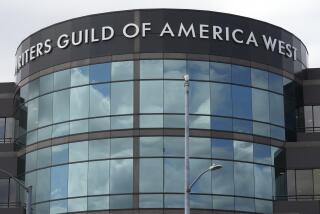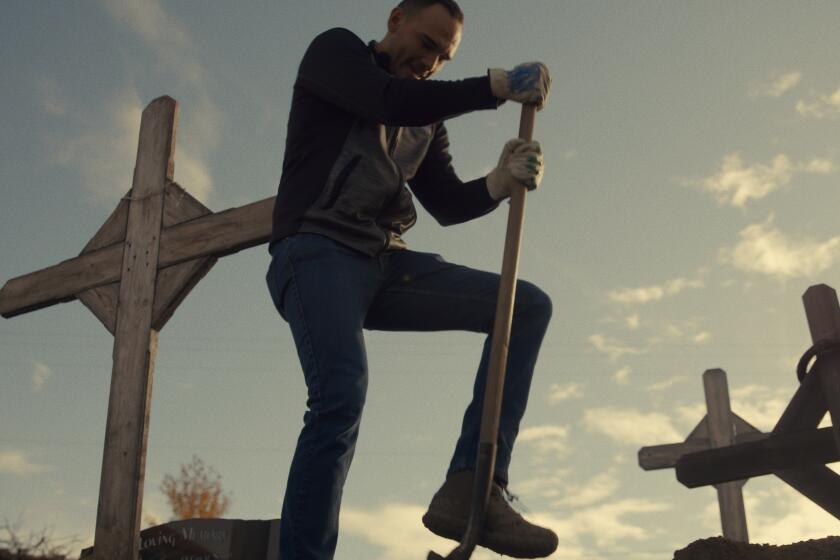Animation Guild board defends contract deal as some members critique AI terms

- Share via
As Hollywood grapples with worries about the threat of artificial intelligence, the union that represents animators is facing dissent over its latest deal with major studios.
Three Animation Guild negotiations committee members said they will vote “no” on a tentative contract the guild reached with their employers, saying the AI protections they wrangled don’t go far enough.
“I believe the A.I. and outsourcing protections in this contract are not strong enough — and in my opinion — could lead to the loss of a lot of jobs,” wrote negotiations committee member Michael Rianda, who directed the animated film “The Mitchells vs. the Machines,” on Instagram. “Real members lives could be hurt by not having these protections.”
The Animation Guild’s executive board disputed any notion that the deal lacks support, saying in a statement that more than 90% of the negotiations committee table team backed the tentative agreement and recommend ratification.
“Generative AI is a complex and deeply concerning issue for our industry, and we recognize the passion and apprehension it has sparked among our members,” the executive board said. “It’s also important to understand that union contracts alone cannot solve this challenge, as seen in the recent contracts of other entertainment unions with far larger memberships and leverage than our own.”
The animation guild reached an agreement with the Alliance of Motion Picture and Television Producers, which represents major studios, last month. Animation Guild members will have until the end of Dec. 22 to vote on the contract.
OpenAI on Monday said it will release its controversial text-to-video tool to the public with different subscription tiers.
The guild touted several gains in the three-year deal, including increases to health and pension funds and wage increases of 7% in the first year, 4% in the second and 3.5% in the third. The pact features AI protections that include notification and consultation provisions; protections for remote work; and the recognition of Juneteenth as a holiday.
The guild represents more than 6,000 artists, technicians, writers and production workers in the animation industry.
“After weeks of negotiations that covered months in the calendar, I am very proud of the agreement that we reached with the studios for our new contract,” Steve Kaplan, business representative for the Animation Guild, said in a statement when the deal was struck. “Not only have we seen the inclusion of the advancements in the industry realized by the other Unions and Guilds, but we were able to address industry-specific issues in a meaningful way.”
Rianda said in his Instagram post that the guild did not secure staffing minimums “to protect crew sizes from AI job loss.” If the tentative contract is not passed by guild members, the union will go back to the table with AMPTP. If those talks are unsuccessful, the union could call for a strike authorization vote.
“Voting ‘No’ could give us the leverage we need to actually get substantial gains,” wrote Kelly Lynne D’Angelo, a television and musical writer, who also was on the guild’s negotiations committee, on Bluesky. “Does it mean we may lose other things negotiated? Yes. But do those things trump more needs in A.I., Outsourcing, and Staffing Minimums? That’s YOUR call to make.”
Multiple union locals representing Hollywood’s below-the-line workers have pushed for overall minimum staffing requirements but have gotten little traction. The Animation Guild’s tentative contract does include a minimum staffing provision with guaranteed employment length for animation writers. The Writers Guild of America managed to secure minimum staffing protections in TV writers rooms last year after going on strike.
Many Hollywood workers are concerned about potential job losses from artificial intelligence. Proponents of AI say that the technology could help bring costs down, give freedom to test bold ideas and speed up production.
A behind the scenes look at a film gala held in San Francisco that screened movies made with artificial intelligence.
A study released earlier this year estimated 62,000 entertainment jobs could be lost to AI within the next three years, including roles in 3-D modeling and character and environment design. The study was commissioned by the Animation Guild, the Concept Art Assn., the Human Artistry Campaign and the National Cartoonists Society Foundation.
Those concerns have boosted interest from workers in joining the guild, also known as IATSE Local 839. The Times reported that from December 2021 to December 2023, nearly 1,000 animation professionals from a dozen different studios were cleared to unionize under the Animation Guild, which was founded in 1952.
Committee member Joey Clift, a writer on Netflix’s “Spirit Rangers,” said that AI protections were among the top priorities for members, but the tentative contract falls short.
“We fought tooth and nail and received a few small AI protections in this contract, but these aren’t the strong, common sense AI guardrails we need to keep animation workers protected,” Clift wrote on Bluesky, adding that he plans to vote “no.”
Animators have expressed great concern over the threat of artificial intelligence, which is expected to lead to job losses.
More to Read
Inside the business of entertainment
The Wide Shot brings you news, analysis and insights on everything from streaming wars to production — and what it all means for the future.
You may occasionally receive promotional content from the Los Angeles Times.














